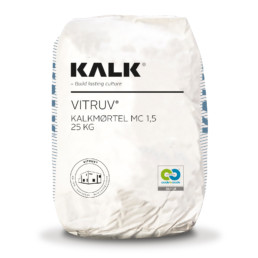KALK has developed a mortar without cement, which can be used in new construction projects and can even be recycled, making it the world’s first mortar to be Cradle-to-Cradle Gold certified.
KALK’s main invention, Vitruv Function Mortar, is the world’s first Cradle-to-Cradle Gold certified mortar. Following ancient building methods, the mortar is based on lime, sand and nothing else.

By using lime instead of cement, the mortar can be made at a lower temperature than cement-based mortar, and can reabsorb CO2 when it hardens. Vitruv mortar also allows masonry to be disassembled, enabling both the mortar and bricks to be recycled for new buildings. KALK collaborates with the REBRICK project to recycle mortar washed from bricks. This way, up to 20% recycled mortar can be mixed with the Vitruv mortar. KALK’s production is powered by wind energy from the company’s own wind turbines, and in time the company aims to be completely waste-free.
We have developed Vitruvius Function Mortar so we can once again build sustainable houses that can stand for thousands of years – completely free of cement.
Rasmus Jørgensen – CEO, KALK.
Why you should care
Buildings and construction are responsible for 36% of CO2 emissions in Europe and generate 30% of the region’s total waste. By making both mortar and construction materials recyclable, waste and demand for new materials from the sector can be greatly reduced, leading to less CO2 emissions.
How the Global Goals are addressed
Industry, innovation and infrastructure
By embracing resource efficiency and environmentally sound technologies, KALK is contributing to making the mortar and construction industries more efficient and sustainable.
Responsible consumption and production
The company KALK’s Vitruv mortar is entirely recyclable and it’s innovative use of ancient building methods reduces raw material use.
Climate action
The energy efficient production, CO2 absorbing hardening process, and the ability to recycle old mortar result in lower CO2 emissions compared to using cement-based mortars.



